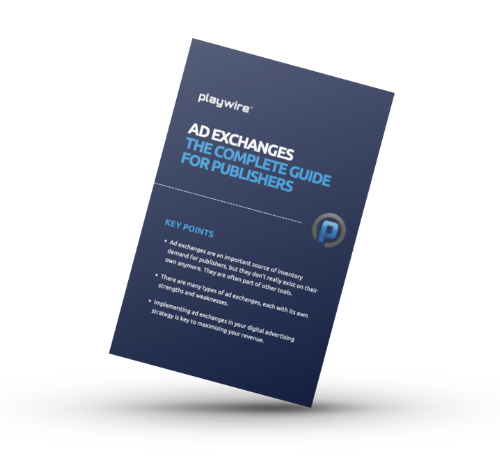Ad Exchange:
The Complete Guide to Ad Exchanges for Publishers
Get a PDF copy of the guide using the form below, or scroll down to read the entire guide right on this page.

What is an Ad Exchange?
Think of an ad exchange as a massive digital marketplace where publishers can sell their ad inventory to multiple advertisers through real-time auctions, much like a stock exchange but for digital advertising space. The exchange acts as a technology platform that automates the buying and selling process, using programmatic technology to match advertisers' targeting requirements with publishers' available ad space in milliseconds, ultimately aiming to maximize revenue for publishers while helping advertisers reach their desired audience efficiently.
Don't Have Time To Read the Entire Guide Now?
We'll email you a downloadable PDF version of the guide and you can read later.
All of our content is generated by subject matter experts with years of ad tech experience and structured by writers and educators for ease of use and digestibility. Learn more about our rigorous interview, content production and review process here.
Built with the expertise of:
Introduction
- Ad exchanges are an important source of inventory demand for publishers, but they don’t really exist on their own anymore. They are often part of other tools.
- There are many types of ad exchanges, each with its own strengths and weaknesses.
- Implementing ad exchanges in your digital advertising strategy is key to maximizing your revenue.
For publishers who are trying to bring in ad revenue, ad exchanges occupy an important position in their demand-generation strategy. Although these tools don’t really exist outside of complementary ad tech offerings and platforms anymore, they are a way to ensure consistently high fill rates and premium CPMs, and that’s exactly the kind of demand publishers of all sizes are looking to generate.
However appealing these demand sources may be to publishers, the world of ad exchanges is relatively complex — particularly for publishers who are in the early stages of building an advertising revenue strategy. Understanding all of the terminology, the available offerings, and how ad exchanges compare to other tools can be confusing. But now that you’re reading this guide, you aren’t going to have that problem anymore.
Below, the Playwire team has put together the definitive guide to ad exchanges for publishers. Here’s everything you need to know.
This guide is meant to simplify the concept of ad exchanges for publishers. It’s an extension of what we do at Playwire: We make ad tech simple for publishers so they can focus on content creation while their revenue soars. Want in on that? Contact us.
table of
contents
Ad Exchange Basics
Ad exchanges are programmatic advertising marketplaces. They are the digital equivalent of a stock exchange or shopping mall — where advertisers and publishers meet to exchange dollars for impressions. One of the most important things to understand about ad exchanges is that they are now rolled into other solutions. In other words, you won’t likely find a standalone ad exchange from which you can source demand. Instead, you’ll find a tool that does something else but offers an ad exchange, as well.
Ad exchanges operate primarily through real-time bidding (RTB), in which single impressions are sold in real time via a programmatic auction. Securing the winning bid in that auction allows the advertiser to place their ad creative on the publisher’s site instantly in order to catch the eyes of the website user who unknowingly triggered the auction only a fraction of a second ago.
The ad exchange facilitates these RTB purchases by connecting a large number of advertisers with an enormous pool of impressions funneled into the exchange by a large network of publishers. On the advertiser side, gaining access to an ad exchange means reaching a potentially wide audience across tons of digital publishers. On the publisher side, gaining access to an ad exchange means exposing your digital ad inventory to high CPMs from a wide variety of buyers.
Ad Exchange vs. Ad Network
Ad tech is a breeding ground for vocabulary mix-ups. Many of the numerous tools publishers and advertisers use to conduct their digital advertising businesses sound alike to the layperson. Ad exchanges are by no means immune to this problem.

Specifically, “ad exchange” and “ad network” are often used interchangeably. While these two types of tools both facilitate the buying and selling of digital advertising, they operate in fundamentally different ways. And the differences between the two actually make a big difference for publishers.
The key is in how exchanges and networks make their money. On ad exchanges, publishers and advertisers interface directly via RTB, and the exchange takes a small percentage of any money exchanged between the two parties. Ad networks, on the other hand, buy inventory directly from publishers at the lowest possible price and resell it to advertisers at the highest possible price, surviving on the spread between those two price points.
As you can see, motivations are going to be quite different on the two types of platforms. Ad exchanges benefit from publishers selling their inventory at higher prices, while ad networks make more money if you sell your inventory for less. That’s why ad exchanges have become a publisher favorite over time.
Types of Deals on Ad Exchanges
We have described the basics of how ad exchanges operate, but we have so far glossed over a key point: There’s more than one type of deal available on an ad exchange. In fact, there are several types, depending on how you want to categorize them.
First, you can break down the types of ad exchange deals by how they operate, leaving you with these three categories:
- Open exchanges
- Private marketplaces
- Preferred deal exchanges
Within each category, you may encounter ad exchanges that specialize in or exclusively deal with a particular type of advertising. That means any ad exchange can deal with one or a combination of the following:
- Display ad exchange
- Mobile ad exchange
- Video ad exchange
Below, we go into more detail about each of these types of ad exchange deals and inventory types.
Open Exchanges
Sometimes referred to as public marketplaces or open auctions, open ad exchanges are what they sound like: open. That is, pretty much any advertiser or publisher can join an open exchange and begin buying or selling digital media.
The vast majority of ad exchanges are open exchanges. However, a growing number of exchanges are either becoming more closed or adding a more exclusive closed component to their membership options. That’s largely due to problems like ad and impression fraud that can run rampant when exchanges and similar environments inadvertently allow in bad actors.
Private Marketplaces
While private marketplaces (PMPs) — often called private ad exchanges — are usually quite a bit smaller than open exchanges, they can pay off for publishers in a big way because they often offer higher average CPMs. The reason for that is twofold:
- More exclusive buyers, who are highly motivated to reach exclusive audiences, tend to prefer private marketplaces.
- Because there is a vetting process for admission to private ad exchanges, problems like ad fraud, brand safety issues, and ad impression fraud are much less common. That gives advertisers more confidence and raises the average price per unit sold.
Preferred Deal Exchanges
Preferred deal exchanges are not exactly a standalone type of ad exchange. They are actually a variant of PMPs. The key difference between preferred deal exchanges and standard PMPs is that publishers can sell their inventory to a preferred (and exclusive) list of advertisers in preferred deal exchanges — rather than just any buyer who happens to gain access to the exchange.
Of course, most buyers aren’t going to care about being on your preferred list unless you’re a well-known name in publishing. However, if you rise to that level, you can expect some of the highest CPMs in the business from preferred deals.
Display Ad Exchanges
Display advertising is one of the oldest types of digital advertising, so it makes sense that the first ad exchanges focused solely on display inventory. Some still maintain this focus, although most have branched out from display to accommodate video and other types of more complex (and often more valuable) inventory.
Still, display advertising is the backbone of countless publisher revenue strategies, and selling display inventory on ad exchanges is still a worthwhile pursuit for the publisher who wants to grow their revenue.
Mobile Ad Exchanges
Mobile ad exchanges are those that facilitate the buying and selling of in-app ad inventory. This type of exchange can encompass both mobile display and mobile video, and many mobile ad exchanges also sell desktop inventory.
Video Ad Exchanges
You’re probably catching on to the pattern by now. Video ad exchanges are ad exchanges that facilitate the buying and selling of video ad inventory. Like the other types of ad exchanges listed here, video ad exchanges can focus solely on video media or branch out into display, app, and other channels.
While video ad exchanges are somewhat newer than display exchanges, they offer a way into the world of higher CPMs that video advertising can open up for publishers. Of course, to participate in a video ad exchange, you have to have some kind of video content — or at least a video player — you can monetize with video ads.
Who Should Use an Ad Exchange?
Although they are almost always part of some other ad tech tool, ad exchanges are a tool themselves. They are not a comprehensive solution to the complex problem of maximizing your revenue as a publisher. With that said, tools are useful — they’re how we get things done. In this case, they are a way for publishers to broaden the demand for their inventory and make more money.
Who should use an ad exchange? Any publisher who is looking to increase their ad revenue. However, it’s important to remember that ad exchanges are only one source of demand. For mid-size or larger publishers, focusing solely on ad exchanges as a source of revenue would likely be a mistake.
Why? Because other sources of demand and revenue — such as header bidding and direct sales — can bring in demand from buyers who might not use ad exchanges and CPMs that can be higher than what you might find on an ad exchange.
Not all ad exchanges are created equal (we get into some of the higher-quality ad exchanges below), but they all operate as a facilitator of impression buying and selling, and they make money off of a portion of each dollar that flows through their system. That’s just one example of how ad exchanges may not always provide the highest available yield. That example is not meant to deter you from using ad exchanges — only to remind you that ad exchanges are a single piece of the revenue puzzle and not the whole picture.
How Ad Exchanges Fit Into the Publisher Tech Stack

You’ve got your website or app, content management system (CMS) or software development kit (SDK), ad server, host, supply-side platform (SSP), header bidders, consent management platform (CMP), brand safety and identity solution, ads.txt file and more.
.png?width=3500&name=Web-Ad-Tech-Stack%20(1).png)
And now you’re thinking about ad exchanges. Where do they fit into your tech stack? Here’s what you need to know.
You Probably Need More Than One
While you don’t technically have to implement a single ad exchange for your tech stack to function correctly, implementing just one isn’t likely to broaden demand for your inventory to the point that you want it to. The good news is that you don’t have to just pick one. You can roll several ad exchanges into your demand stack to make sure you’re consistently getting the highest available CPMs and a 100% fill rate.
Which ad exchanges you choose will depend on your unique needs and, if you’re hoping to attract private or preferred deals, your own qualifications and reach as a publisher. However, it’s important to remember that you aren’t stuck with any particular ad exchange. If you implement one and it isn’t working as well as you want it to, you can always yank it from your programmatic setup and plug in a new exchange.
Ad Exchanges Are Almost Always Part of Something Else
You don’t have to dig too deeply into ad tech and digital advertising to stumble across information about ad exchanges. Publishers often become aware of exchanges early in their own processes of setting up a digital advertising revenue strategy. But awareness of exchanges sometimes leads to confusion. That’s because it can be difficult to find tools that are only ad exchanges.
Some companies still do maintain standalone ad exchanges, but they are becoming rarer by the minute. That’s because legacy ad exchanges routinely get purchased by bigger ad tech companies and rolled into a more comprehensive offering. If not that, then other ad tech tools are creating their own ad exchanges and offering them as part of a comprehensive solution.
For example, historically SSPs and ad exchanges were different things. But today, almost all ad exchanges have been absorbed by SSPs or larger offerings (like Google Ad Exchange), profoundly blurring the lines.
Similarly, on the video ad exchange side, many ad servers that handle video ads have also built their own video ad exchanges. Ad tech companies are businesses looking to turn a profit, so when they see an opportunity like ad exchanges and realize they already have access to a large number of publishers or advertisers, they’re likely to jump at the opportunity to create an exchange of their own.
For publishers, this fact can be a little frustrating. You may already have the other parts of a two-for-one ad exchange and ad tech tool combo package covered, and the idea of transitioning to an entirely new tool just to get a new ad format might be exhausting or anxiety-inducing. Fortunately, many tools allow you to pick and choose which parts of the offering you implement, and some standalone ad exchanges are still out there.
How Does an Ad Exchange Work?
If you’re as excited by the technology in ad tech as the Playwire team is, you will enjoy this section. We’re going to get into how ad exchanges work. We know what they do, and that’s what is most important to publishers, but an understanding of how these things actually function can help you place exchanges in their appropriate sphere within your ad tech concerns.
To understand how ad exchanges work, you first must recognize that the following components are involved in the process:
- The publisher
- The advertiser
- The ad exchange
- A demand-side platform (DSP)
- An SSP
- An ad server
- An individual user who visits your site or app
And here is how all of those pieces work together:
1
2
A user visits your website or app, and loads an ad placement, which triggers an impression to be sent to the exchange’s auction.
3
4
5
6
7
8
The ad server serves the ad creative in the appropriate ad slot on your site or app.
All of that happens in a fraction of a second — the time between when the user initiated the load of your website or app and when the website or app actually appears before the user’s eyes. Not only does this happen in milliseconds, but it happens countless thousands of times per minute across an enormous network of exchanges, publishers and advertisers.
Benefits of Ad Exchanges for Publishers
We have already said a couple of times that ad exchanges are a more or less essential part of any publisher’s efforts to maximize their ad revenue. That statement implies that there are some benefits of ad exchanges for publishers, and that’s certainly true. Here are some of the key benefits you can expect if you incorporate ad exchanges into your revenue strategy:
You Set the Minimum CPMs
When you work with an ad exchange, you get to set many of the rules of the auctions that will take place for your ad inventory. One of the key rules is your minimum CPM — or the lowest amount you’re willing to accept for an impression.
Adjusting minimum CPMs is a key part of yield optimization, and maintaining the level of control necessary to do that is important if you are looking to maximize your revenue. That way, if you only get insultingly low bids for a particular impression, the ad exchange will not facilitate the programmatic deal, and your average CPM will be intact.
You Automate Part of Your Revenue
For the most part, ad exchanges are a function of programmatic advertising. That means much of the impression selling process is automated. As any busy publisher knows, automation is the next-level innovation that can turn an unmanageable daily schedule into a manageable one.
Really, to sell ad placements at scale as a publisher of medium to large size, you have to automate part of the process. There’s no way you or someone on your staff could oversee thousands or hundreds of thousands of ad sales every day. And the good news is, thanks to tools like ad exchanges, you don’t have to.
After the early technical lift of setting everything up and linking the ad exchange into your programmatic ecosystem, the minute-by-minute process of selling your inventory is largely automated. Don’t forget, though, that you will still need a live human being to oversee your ad sales efforts as a whole to make sure your yield is at its optimal level at all times.
You Maintain Control
Digital advertising is still very much a new frontier, and that means opportunists and bad actors are still finding ways to get in and game the system for a quick buck. On top of that, the internet is a vast space in which there are plenty of brands you would not want to be shown alongside your content.
Ad exchanges help you solve these problems. You maintain control of who can buy your inventory when you engage with PMPs and preferred deal exchanges, and you can change your settings within the exchange to make sure your content is never associated with brands that would be inappropriate for your audience.
You Get Access to Broad Demand
This is what ad exchanges are really all about: broad demand. You need access to broad demand from buyers if you want to make sure each impression on your website or app is sold — and sold at an acceptable price.
Ad exchanges have that kind of demand, and you can multiply the benefits of that demand by working with more than one exchange.
You Choose the Ad Units and Advertisers
To some degree, all SSPs and ad exchanges allow publishers to choose which types of ad units they allow on their sites or apps. In a similar vein, they allow you to adjust your filters to block certain advertisers or advertisers in particular verticals or categories.
Popular Ad Exchanges for Publishers
Deciding whether you need to use an ad exchange is step one. But then, you’re faced with a bigger, much more complicated question: Which ad exchanges should you use? The reason this question is complicated for many publishers is that there are dozens of ad exchanges, and each one would like all publishers and advertisers to believe that it is the best.
Read the full article: Best Ad Exchange for Publishers.

They can’t all be the best, of course. And they aren’t. However, some tend to be the best in terms of reach, usability, and technology. Those are the ad exchanges we have listed below. Read on to see the best ad exchanges for publishers:
Google AdX
As part of Google Ad Manager (GAM), Google maintains its own ad exchange called AdX. The reason AdX is at the top of this list is simple: It’s a Google product, so it has access to some of the broadest demand there is, it’s user-friendly and it’s on the cutting edge in terms of technology.
Keep in mind that only publishers who have been invited to GAM can get access to AdX, and while Google AdSense serves a similar function, it is not the same as an ad exchange. Even if you aren’t a large enough publisher to get your own AdX account, you can work with a Google-certified publishing partner like Playwire to get access to the exchange and all of its benefits to your revenue.
Verizon Media
Like Google, Verizon is one of the giants in media, and that includes digital advertising. The company Verizon Media, formerly known as Oath, connects publishers to its own enormous buyer demand, as well as that of other media giants like Amazon and Facebook.
Xandr
Xandr is the AT&T-powered ad tech giant that resulted from the acquisitions of several other giants in the ad tech space, such as AppNexus. While mergers and acquisitions among ad tech tools are not always beneficial to publishers, the result of the particular acquisitions that gave us Xandr is a shockingly large amount of demand from buyers around the world.
Xandr is not just an ad exchange, either. Like Google, the company rolls a wide variety of publisher services into its offering, including servers and SSPs.
OpenX
OpenX is a well-known name in various arenas of ad tech, and that includes ad exchanges. The company maintains a comprehensive ad exchange alongside its header bidding and yield optimization offerings. On top of that, OpenX offers a mobile-forward ad exchange that appeals heavily to both buyers of app inventory and the publishers who sell it.
Magnite
Magnite is one of those ad exchanges that was originally an SSP. Over time, the company, which was not called Magnite until quite recently, evolved and added offerings that would eventually amount to a full-blown ad exchange.
Formerly known as the Rubicon Project, Magnite has managed to attract some of the largest publishers in the world to its ad exchange. That’s due in large part to its access to a wide network of advertisers, but it’s also an effect of the tool’s ability to facilitate PMP and preferred deals, as well as open deals, on its exchange.
Pubmatic
PubMatic is a long-standing staple of many publisher ad tech stacks in one form or another, whether it’s as an open-source header bidding wrapper or a high-yield PMP. The company has also invested heavily in tools that can filter out invalid traffic, making it a highly attractive ad exchange for publishers and advertisers who put a premium on brand safety.
Index Exchange
Index Exchange focuses heavily on its ad exchange offering — in particular, the tool has placed a lot of effort on maintaining and improving the quality of its exchange, which has led to trusted relationships with a wide variety of buyers across industries and around the world. The exchange can facilitate the sale of inventory on multiple channels, including display, video, mobile, app, connected TV (CTV), and over the top (OTT).
Ad Exchange FAQs
As a concept to discuss, ad exchanges are relatively simple. But they become more complicated as you get closer to actually deploying them in your revenue strategy. That’s why so many publishers are left with heads full of questions after their first couple of passes at setting themselves up on ad exchanges.
To help, the Playwire team has put together this list of questions and answers about ad exchanges. Here are the answers you’ve been looking for.
Why Use an Ad Exchange Instead of an Ad Network?
As a general rule, ad exchanges want publishers to make more money, and ad networks want them to make less. That all comes down to the different ways ad exchanges and ad networks do business between publishers and advertisers.
Ad exchanges facilitate programmatic deals and take a percentage of the money spent. Ad networks buy publishers’ inventory at low prices and resell it for high prices. You want to sell your inventory for as much as possible, which is why an ad exchange is likely to be more beneficial to you.
What Is the Biggest Ad Exchange?
Because Google is a given in almost every major publisher’s list of demand sources, Google’s AdX ad exchange is likely the largest ad exchange in the world. In truth, you don’t have access to the broadest possible demand if you aren’t working with Google’s products, and that’s why nearly every publisher of note is using AdSense or GAM in some way.
How Do Ad Exchanges Make Money?
Ad exchanges don’t typically charge a monthly or one-time fee to publishers who use them. Instead, they take a cut of each dollar that flows through their programmatic ecosystems. The exact amount varies from exchange to exchange, but as a general rule, ad exchanges make more money when publishers make more money (or when advertisers spend more).
Do I Need an Exchange That Is Dedicated to My Primary Channel?
Not necessarily. While you can derive some benefits from working with, for example, an ad exchange that only handles mobile inventory if you’re an app publisher, it’s not a make-or-break qualification.
Many ad exchanges can handle multiple types of inventory with no problem, and you can always try out the bigger, broader ad exchanges before implementing the smaller, more focused options.
Are Ad Exchanges Dying?
Dying isn’t the right word. Evolving is probably more in line with what’s really happening. Ad exchanges have been around for a while, but now, they are becoming rare as standalone tools. Larger ad tech tools and platforms are acquiring them and rolling them into more comprehensive digital advertising solutions.
For publishers, this isn’t necessarily good or bad. It’s simply something to be aware of as you start thinking about adding ad exchanges to your digital ad revenue strategy.
Do I Have to Be a Developer to Integrate an Ad Exchange?
While hooking an ad exchange into your overall programmatic setup isn’t easy in general terms, it’s relatively straightforward as far as ad tech tools go.
Would it be easier to do if you had a deep understanding of server logic and coding? Absolutely. But is that really necessary? Not at all. Ad exchanges have a vested interest in being easy to use, so most have dedicated some resources to creating user-friendly interfaces, detailed instructions, and effective support teams.
What’s the Difference Between an Ad Exchange and a DSP?
Advertisers and agencies use DSPs to connect with impressions that are relevant to their campaigns, and ad exchanges provide access to those impressions. It’s not difficult to understand why the two ad tech terms might get confused — and they often do.
Think of it like this: A DSP connects to an ad exchange to receive impressions that might be attractive to the advertiser, and then it decides whether to bid on those impressions on the advertiser’s behalf.
What’s the Difference Between an Ad Exchange and an SSP?
SSPs help publishers manage their inventory and send it to various demand sources, including ad exchanges. Ad exchanges, on the other hand, enable publishers and advertisers to buy and sell impressions. Because SSPs handle so much publisher inventory, many have decided to cut out the ad exchange middle man by creating their own exchanges, which is a key reason why these two terms are often used interchangeably.
Who Are the Common Buyers on Ad Exchanges?
As a publisher looking to maximize your revenue, you have a clear reason to want to connect with big brands and companies that can afford to pay high prices for premium inventory. So, are you going to find that kind of demand on ad exchanges?
In general, yes. It depends, of course, on the particular ad exchanges you use, but many of the world’s largest buyers routinely use ad exchanges in their campaigns.
However, it’s important to note that some of the larger brands prefer to directly interface with premium publishers to purchase the highest-value impressions. This is why ad exchanges are only one part of a complete revenue strategy for publishers.
Do I Have to Manage My Ad Exchanges Myself?
You probably won’t end up integrating just one ad exchange into your list of demand sources. Most large publishers integrate several ad exchanges, among many other demand sources like header bidders. And that can all become a headache to manage.
Do you have to manage it all yourself? Absolutely not. In fact, at a certain point, you have to decide whether you are going to hire an entire team to manage your digital ad sales efforts or outsource the management of the entire operation to a third party like Playwire.
Final Thoughts
Any publisher who hopes to maximize their revenue is not likely to succeed at that goal without adding some ad exchanges to their advertising revenue strategy. It’s just common sense — access to broad demand in a fair and transparent programmatic marketplace is a great way to ensure that no ad impression goes unfilled and your CPMs are consistently high.
That’s the benefit of ad exchanges for publishers, but there’s a downside when it comes to setting up and managing ad exchanges as you try to grow your revenue. While some aspects of the publisher ad tech stack are clearly much more complicated than exchanges, these tools are no walk in the park for a publisher with limited technical knowledge.
Fortunately, there are some simplified solutions, which you can find in the form of made-for-publisher ad exchanges from the giants like Google. But there’s an even simpler — and more effective — solution: working with Playwire.
Playwire maximizes revenue for publishers. We’ve been doing it a long time, and ad exchanges have been a part of that effort for years now. Sure — you can set it all up and manage it yourself, but do you have the time or energy to? And more importantly, do you have the expertise to run your ad exchange game in a way that will truly maximize your revenue?
Our team has all those things in spades. We can handle ad exchanges and every other part of your revenue strategy while you focus on creating content and growing your audience. If you’re ready for an arrangement like that, we’re ready to hear from you. Reach out to Playwire online today.
Related Content

Interested in learning more about ad exchanges?
You can learn more by diving deeper into any of the below articles:
- What is an Ad Exchange?
- Video Ad Exchanges: Everything Publishers Need to Know
- Guide to Google's Ad Exchange
- Mobile Ad Exchanges: Everything Publishers Need to Know
- Best Ad Exchanges for Publishers
- How an Ad Exchange Works
- What is an Open Ad Exchange?
- 7 Benefits of an Ad Exchange Platform
- Ad Exchange vs. Ad Network
Amplify
Your Ad Revenue
Accelerate your business and uncomplicate your ad tech stack, because you deserve a partner and a platform that demands more for you.

